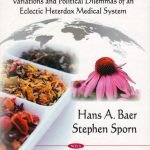Daniel Chong, ND
Joel Kahn, MD, FACC
Heart failure (HF) is a syndrome of cardiac dysfunction in which the heart can no longer pump enough blood around the body to support its organs and systems. Identified risk factors for HF include conditions that damage the heart, such as hypertension, coronary heart disease, heart attack, and diabetes; also lifestyle factors such as smoking, obesity lack of exercise, and a high-fat and/or high-sodium diet.1 While HF may occasionally come on suddenly for certain reasons, the majority of cases are typically chronic and worsen over time without care. For the purposes of this article, HF will refer to chronic HF specifically. If untreated or poorly-treated HF continues to worsen, it will eventually become congestive heart failure (CHF), in which fluid may back up into the lungs, liver, gastrointestinal tract, arms, and/or legs. HF afflicts over 5 million persons in the United States, at a cost of over $30 billion yearly.2 It also accounts for over 1 million hospital admissions yearly and is the cause of 1 out of every 9 deaths.2 With over 800 000 hospital admissions for HF occurring each year, despite only a minority ending up truly requiring acute care, hospital initiatives have been launched to decrease readmissions for HF within the first 30 days of discharge.3
The Role of Myocardial Bioenergetics
In HF, altered physiological mechanisms commonly include altered cardiac metabolism and reduced energy stores, with depleted ATP production in mitochondria.4 Consideration for the unique differences inherent in myocardiocyte metabolism relative to the rest of the body (an approach initiated by early orthomolecular physicians and researchers, then further refined and popularized by Stephen Sinatra, MD, and James Roberts, MD) will guide us toward a thorough, effective group of therapeutic interventions that comprehensively address the heart’s special needs. It is important, for example, to note that the concentration of mitochondria in heart cells is relatively greater than any other cell type in the body, suggesting that support of mitochondrial function during HF may be of particular importance in a comprehensive treatment plan for this condition.5 Similarly, heart cells also uniquely utilize glucose, use fatty acids as their primary fuel source, and can become severely affected by intracellular magnesium deficiency.6-8
Unfortunately, in spite of the recognized needs of myocardiocytes, conventional therapy of HF continues to focus on neurohumoral support of the failing heart (ie, reversing beta-receptor downregulation and inhibiting the effects of angiotensin II and aldosterone), without directly addressing these key aspects of myocardial bioenergetics. Not only do such therapies focus on symptom reduction (as opposed to treatment of causal factors), forthcoming information will also show how these medications can worsen quality of life and hinder recovery by contributing to key nutrient deficiencies that may already be problematic for the HF patient.
The potential to therapeutically augment cardiac function and reduce morbidity and mortality in HF by specifically altering myocardial bioenergetics has tremendous appeal and growing support from the scientific literature. This approach, combined with therapeutic lifestyle strategies, addresses the root cause of the dysfunction and has the potential to bring about improved function and quality of life without side effects.
The Awesome Foursome
An orthomolecular approach to improving myocardial bioenergetics was proposed at least a few decades ago.9,10 However, Dr Stephen Sinatra may be given credit for popularizing a metabolic therapy approach to HF in 1990s when he began using supplements in his cardiology practice to restore cardiac energy production. Based on earlier research findings, Dr Sinatra recommended coenzyme Q10 (CoQ10), L-carnitine, and magnesium, and identified beneficial responses.11 His aforementioned colleague, Dr James Roberts, suggested adding D-ribose powder to the combination, and the “Awesome Foursome” was created, as detailed in Dr Sinatra’s book.12 These agents will be featured here as primary therapeutic interventions that seek to address the unique needs of this crucial organ.
Coenzyme Q10
An antioxidant and critical component of cardiac energy production, CoQ10 is concentrated in healthy heart muscle and can become deficient in the myocardiocytes of patients suffering from HF.13 A meta-analysis of 11 studies, assessing CoQ10 supplementation (60-200 mg/day) over 1-6 months, found there was a 3.7% increase in ejection fraction using CoQ10 supplementation.14 With consideration for the depleting effects statins can have on CoQ10 levels, a recent randomized trial combining CoQ10 and atorvastatin in the therapy of HF also reported an increase in ejection fraction and an improvement in the symptoms of HF.15 The most definitive evidence, the Q-SYMBIO study, was a placebo-controlled, double-blind, randomized trial of patients with chronic HF.16 In this study, 420 HF patients were randomized to CoQ10 (100 mg TID) or placebo and followed for 2 years. At 16 weeks, there were no differences between the 2 groups in heart function, 6-minute walk test, or circulating biomarkers (brain natriuretic peptide, or BNP). However, the long-term, primary endpoint of a composite of major adverse cardiovascular events was reached by 26% of the placebo, vs only 15% of the CoQ10 group.16 In addition, cardiovascular mortality, all-cause mortality, and incidence of hospital stays for chronic HF were significantly lower in the CoQ10 treatment arm.
L-Carnitine
L-carnitine is believed to improve mitochondrial function by shuttling long-chain acyl groups from fatty acids across organelle membranes.17 Considering the significant impact dysfunctional mitochondria appear to have in the pathogenesis of HF, expectations for the positive impact of L-carnitine supplementation in this condition should be high, and studies thus far have been encouraging. A 2000 study showed statistically significant improvements in mortality rate among HF patients supplemented with L-carnitine (2000 mg/day), compared to placebo.18 A 1988 study also found 2000 mg/day to have therapeutic benefit in HF.19 Some questions still remain, however. While a recent meta-analysis of 13 trials involving 3629 subjects showed L-carnitine was associated with a 27% reduction in all-cause mortality, a 65% reduction in ventricular arrhythmias, and a 40% reduction in angina, there was no significant reduction in the rate of HF or myocardial reinfarction.20
D-Ribose
D-ribose shares the structure of the backbone of ATP and is a 5-carbon sugar, affording it some unique properties that show promise in the treatment of HF. Animal research has shown that heart cells subjected to ischemia (acute or chronic) experience a reduction in ATP production capacity.21 What’s more, while recovery from the effects of ischemia is typically sluggish due to certain rate-limiting enzymatic steps in the pentose phosphate pathway (PPP), supplemental D-ribose appears able to enter the PPP and bypass the rate-limiting steps, leading to improved efficiency of ATP production.21,22
Importantly, human clinical trials have shown related effects. A 1992 study of stable but severe coronary artery disease patients found that supplementing these patients with D-ribose enabled them to increase their “ischemic threshold” and exercise longer with fewer symptoms.23 Additional studies have demonstrated similar effects of D-ribose on the enhancement of depleted cellular energy stores following ischemia.24 The same authors also reviewed preclinical and clinical trials examining D-ribose that demonstrated its ability to improve diastolic heart function, quality of life, and ventilatory parameters.25
Magnesium
Magnesium is a crucial cofactor in many pathways involved with cardiac bioenergetics, yet is understudied (and underutilized) in conventional cardiology.26 Compounding this problem, recent research has shown that nearly half of all Americans do not consume recommended amounts of magnesium from the foods they are eating.26 The likely deficiency created by such poor intake is then amplified by various pharmaceutical agents frequently prescribed to these same people, such as certain types of antacids, antibiotics, and birth control pills. HF patients – the very people who may need magnesium the most – are also frequently prescribed medications for their condition that further worsen the likelihood of magnesium deficiency, namely diuretics and the cardiac glycoside, digoxin.27 It is interesting to note in one study that higher serum magnesium levels in patients hospitalized for HF were actually associated with increased all-cause mortality.28 However, after adjusting for baseline differences, this association was no longer significant, and factors such as advanced age and poor renal function were considered more likely than magnesium to be related to the excess risk.28
Given that magnesium has effects on over 300 enzymatic processes and is the second most abundant intracellular cation (next to potassium) in the human body, the mineral certainly plays a significant role in human health beyond its impact on heart function.29 Key heart-related functions of magnesium, all of which would impact HF, include impacting potassium’s role in electrical conductance, and modulating heart cell function by contributing to the maintenance of the sodium/potassium- and calcium gradients of the cardiac cell membrane. Thus, through various means, magnesium exerts a powerful influence on the electrical and contractile functions of the myocardium.29 Its physiological contributions to cardiac function, in turn, suggest the important role a deficiency would play in HF, and an equally important role optimization of tissue magnesium levels would play in its treatment. Research in support of this conclusion has thus far been promising, including cardiac arrhythmias – frequently seen in HF patients – responding positively to both long-term oral supplementation30 and acute IV administration of magnesium.31 A recent double-blind, placebo-controlled study also showed magnesium orotate supplementation over the course of 1 year to improve survival rate in severe HF patients by nearly 25%, while also significantly improving their symptoms and quality of life.32
Additional Supplements
Taurine is a sulfur-containing amino acid that may augment the role of conventional medications for HF because of its role in inhibiting the harmful effects of catecholamines and angiotensin II in HF.33 In a randomized study of placebo vs taurine supplementation in HF, at a dose of only 500 mg TID over 2 weeks, various aspects of exercise performance increased significantly in patients receiving the active supplement.34
Berberine is a quaternary ammonium salt found in medicinal plants such as goldenseal, Oregon grape root, and coptis. In a study of 156 patients with CHF, in which all patients were given conventional medications for the disease, those who were also given 1.2-2 g of berberine per day experienced improvements in ejection fraction, exercise capacity, and dyspnea, as well as a decrease in the frequency of complex premature ventricular contractions (PVCs), compared to the placebo group.35 Long-term follow-up also revealed a significant decrease in mortality rate in the berberine-supplemented group.35
Various known physiological effects of berberine, including inhibition of smooth muscle contraction, reduction of inflammation, platelet aggregation inhibition, and inhibition of ventricular tachyarrhythmias, may help explain its apparently potent effects on HF patients.36,37 Nonetheless, there is some suggestion that long-term use of berberine may inhibit cytochrome P450, resulting in various potentially negative effects on the clearance of drugs and possibly other toxins; thus, caution is warranted until further study can elucidate the impact of such findings.38
AB is currently an 87-year-old woman who lives independently and enjoys friends and family events. Three years ago she was admitted to a local hospital with shortness of breath, fatigue, and edema, and was diagnosed with congestive heart failure.
Exam & Treatment
An echocardiogram identified an enlarged heart, a reduced ejection fraction of 35%, and moderately severe mitral regurgitation. A coronary angiogram showed normal arteries. She was begun on diuretics, carvedilol, and an ACE inhibitor. She was considered for a mitral valve clipping to reduce the amount of valve insufficiency. After several consultations for this new procedure, she consulted with Dr Kahn, and a metabolic cardiology program was instituted on top of the standard medications. She began CoQ10 (400 mg/d), L-carnitine (500 mg BID), D-ribose powder (5 g TID), and magnesium taurate (250 mg/d).
Follow-up
AB remained free of dyspnea over the coming months, and a follow-up echocardiogram 4 months later demonstrated her left ventricle to be of normal size, her ejection fraction to be 60%, and only mild mitral insufficiency remaining. Now, almost 3 years later, she remains only on carvedilol plus the metabolic supplements, and is free of CHF.
Summary
Heart failure is a serious disorder that can cause great suffering and shorten life. Current therapies with lifestyle alterations and pharmaceutical agents are of value, but can simultaneously worsen certain aspects of the problem and often leave patients limited in quality of life. A thorough and detailed understanding of myocardial bioenergetics, plus a decades-long history of data – some from rigorously performed studies – now exists, providing strong support for the use of nutraceuticals in support of this all too common condition. In fact, for these reasons, coupled with the fact that such therapeutic agents have almost no side effects and rarely interact negatively with pharmaceutical prescriptions, HF can be considered an ideal candidate for this therapeutic approach. In addition, advanced lab tests (eg, NT-proBNP)39 along with ejection fraction testing afford physicians the means necessary to properly and objectively monitor patients and ensure they are experiencing a positive response to the prescribed therapies. As highlighted in the case study featured in this review, an integrated approach can garner excellent results, even in relatively severe cases, improving myocardial bioenergetics, left ventricular function, and quality of life.
 Daniel Chong, ND, has been a licensed naturopathic physician in Portland, OR, since 2000. He maintains a private practice in which he focuses on advanced risk factor assessment and prevention strategies for CVD, men’s sexual health, and other chronic health issues. He also offers long-distance consulting in advanced CV risk assessment and prevention programs for people who are unable to consult him directly. In addition to his naturopathic license, Dr Chong is a candidate for board certification in Anti-Aging Medicine, as well as a fellowship in Metabolic Cardiovascular Medicine from the U of South Florida School of Medicine and the American Academy of Anti-Aging Medicine.
Daniel Chong, ND, has been a licensed naturopathic physician in Portland, OR, since 2000. He maintains a private practice in which he focuses on advanced risk factor assessment and prevention strategies for CVD, men’s sexual health, and other chronic health issues. He also offers long-distance consulting in advanced CV risk assessment and prevention programs for people who are unable to consult him directly. In addition to his naturopathic license, Dr Chong is a candidate for board certification in Anti-Aging Medicine, as well as a fellowship in Metabolic Cardiovascular Medicine from the U of South Florida School of Medicine and the American Academy of Anti-Aging Medicine.
***
 Joel Kahn, MD, FACC, has a strong background and experience in evidence-based, clinically effective, nutritionally-oriented cardiology. He is Clinical Professor of Medicine at Wayne State University School of Medicine, and Director of Cardiac Wellness at Michigan Healthcare Professionals PC. He practices at William Beaumont Hospital, Royal Oak, and Troy. Dr Kahn is a graduate summa cum laude of the U of Michigan School of Medicine. He lectures widely on the benefits of good nutrition and mind-body practices on the cardiovascular system. He also writes for Readers Digest Magazine as the Holistic Heart Doc, and his first book, The Whole Heart Solution, is currently the top-selling cardiology-related book on Amazon.com.
Joel Kahn, MD, FACC, has a strong background and experience in evidence-based, clinically effective, nutritionally-oriented cardiology. He is Clinical Professor of Medicine at Wayne State University School of Medicine, and Director of Cardiac Wellness at Michigan Healthcare Professionals PC. He practices at William Beaumont Hospital, Royal Oak, and Troy. Dr Kahn is a graduate summa cum laude of the U of Michigan School of Medicine. He lectures widely on the benefits of good nutrition and mind-body practices on the cardiovascular system. He also writes for Readers Digest Magazine as the Holistic Heart Doc, and his first book, The Whole Heart Solution, is currently the top-selling cardiology-related book on Amazon.com.
References:
- Centers for Disease Control and Prevention. Heart Failure Fact Sheet. Last updated December 3, 2013. CDC Web site. http://www.cdc.gov/dhdsp/data_statistics/fact_sheets/fs_heart_failure.htm. Accessed August 1, 2015.
- Go A, Mozaffarian D, Roger VL, et al. Heart disease and stroke statistics—2013 update: a report from the American Heart Association. Circulation. 2013;127(1):e6-e245.
- Collins SP, Pang PS, Fonarow GC, et al. Is hospital admission for heart failure really necessary?: the role of the emergency department and observation unit in preventing hospitalization and rehospitalization. J Am Coll Cardiol. 2013;61(2):121-126.
- Ashrafian H, Frenneaux MP, Opie LH. Metabolic mechanisms in heart failure. Circulation. 2007;116(4):434-448.
- Varikmaa M, Guzun R, Grichine A, et al. Matters of the heart in bioenergetics: mitochondrial fusion into continuous reticulum is not needed for maximal respiratory activity. J Bioenerg Biomembr. 2013;45(4):319-331.
- Zimmer HG. The oxidative pentose phosphate pathway in the heart: regulation, physiological significance, and clinical implications. Basic Res Cardiol. 1992;87(4):303-316.
- Lopaschuk GD, Ussher JR, Folmes CD, et al. Myocardial fatty acid metabolism in health and disease. Physiol Rev. 2010;90(1):207-258.
- Theophanides T, Anastassopoulou J, eds. Magnesium: Current Status and Developments: Theoretical, Biological and Medical Aspects. Norwell, MA: Kluwer Academic Publishers; 1997.
- McCarty MF. Toward a “bio-energy supplement”—a prototype for functional orthomolecular supplementation. Med Hypotheses. 1981;7(4):515-538.
- Judy WV, Hall JH, Toth PD, Folkers K. Double blind-double crossover study of coenzyme Q10 in heart failure. In: Folkers K, Yamamura Y, eds. Biomedical and Clinical Aspects of Coenzyme Q10. Amsterdam, Netherlands: Elsevier; 1986: 315-323.
- Foundation for Alternative and Integrative Medicine. Sinatra S. Heart Failure Roundup: The CoQ10, Fish Oil, Statin Connection. February, 2009. FAIM Web site. http://www.faim.org/guestwriters/sinatraheartfailureroundup.html. Accessed May 15, 2015.
- Sinatra ST. The Sinatra Solution: Metabolic Cardiology. Laguna Beach, CA: Basic Health Publications, Inc; 2008.
- Folkers K, Vadhanavikit S, Mortensen SA. Biochemical rationale and myocardial tissue data on the effective therapy of cardiomyopathy with coenzyme Q10. Proc Natl Acad Sci U S A. 1985;82(3):901-904.
- Sander S, Coleman CI, Patel AA, et al. The impact of coenzyme Q10 on systolic function in patients with chronic heart failure. J Card Fail. 2006;12(6):464-472.
- Pourmoghaddas M, Rabbani M, Shahabi J, et al. Combination of atorvastatin/coenzyme Q10 as adjunctive treatment in congestive heart failure. ARYA Atheroscler. 2014;10(1):1-5.
- Mortensen SA, Rosenfeldt F, Kumar A, et al. The effect of Coenzyme Q10 on morbidity and mortality in chronic heart failure: results from Q-SYMBIO: a randomized double-blind trial. JACC Heart Fail. 2014;2(6):641-649.
- Sharma S, Black SM. Carnitine Homeostasis, Mitochondrial Function, and Cardiovascular Disease. Drug Discov Today Dis Mech. 2009;6(1-4):e31-e39.
- Rizos I. Three-year survival of patients with heart failure caused by dilated cardiomyopathy and L-carnitine administration. Am Heart J. 2000;139(2 Pt 3):S120-S123.
- Ghidini O, Azzurro M, Vita G, Sartori G. Evaluation of the therapeutic efficacy of L-carnitine in congestive heart failure. Int J Clin Pharmacol Ther Toxicol. 1998;26(4):217-220.
- DiNicolantonio JJ, Lavie CJ, Fares H, et al. L-carnitine in the secondary prevention of cardiovascular disease: systematic review and meta-analysis. Mayo Clin Proc. 2013;88(6):544-551.
- St Cyr JA, Bianco RW, Schneider JR, et al. Enhanced high energy phosphate recovery with ribose infusion after global myocardial ischemia in a canine model. J Surg Res. 1989;46(2):157-162.
- Omram H, McCarter D, St Cyr J, et al. D-ribose aids congestive heart failure patients. Exp Clin Cardiol. 2004;9(2):117-118.
- Pliml W, Von Arnim T, Stablein A, et al. Effects of ribose on exercise-induced ischaemia in stable coronary artery disease. Lancet. 1992;340(8818):507-510.
- Shecterle LM, Terry KR, St Cyr JA. The patented uses of D-ribose in cardiovascular diseases. Recent Pat Cardiovasc Drug Discov. 2010;5(2):138-142.
- Shecterle LM, Wagner S, St Cyr JA. A sugar for congestive heart failure patients. Ther Adv Cardiovasc Dis. 2011;5(2):95-97.
- Rosanoff A, Weaver CM, Rude RK. Suboptimal magnesium status in the United States: are the health consequences underestimated? Nutr Rev. 2012;70(3):153-164.
- University of Maryland Medical Center. Drugs that Deplete: Magnesium. Available at: http://umm.edu/health/medical/altmed/supplement-depletion-links/drugs-that-deplete-magnesium. Accessed May 15, 2015.
- Vaduganathan M, Greene SJ, Ambrosy AP, et al. Relation of serum magnesium levels and postdischarge outcomes in patients hospitalized for heart failure (from the EVEREST trial). Am J Cardiol. 2013;112(11):1763-1769.
- Fazekas T, Scherlag BJ, Vos M, et al. Magnesium and the Heart: antiarrhythmic therapy with magnesium. Clin Cardiol. 1993;16(11):768-774.
- Bashir Y, Sneddon JF, Staunton HA, et al. Effects of long-term oral magnesium chloride replacement in congestive heart failure secondary to coronary artery disease. Am J Cardiol. 1993;72(15):1156-1162.
- Sueta CA, Clarke SW, Dunlap SH, et al. Effect of acute magnesium administration on the frequency of ventricular arrhythmia in patients with heart failure. Circulation. 1994;89(2):660-666.
- Stepura OB, Martynow AI. Magnesium orotate in severe congestive heart failure. Int J Cardiol. 2009;134(1):145-147.
- Ito T, Schaffer S, Azuma J. The effect of taurine on chronic heart failure: actions of taurine against catecholamine and angiotensin-II. Amino Acids. 2014;46(1):111-119.
- Beyranvand MR, Khalafi MK, Roshan VD, et al. J Cardiol. Effect of taurine supplementation on exercise capacity of patients with heart failure. 2011;57(3):333-337.
- Zeng XH, Zeng XJ, Li YY. Efficacy and safety of berberine for congestive heart failure secondary to ischemic or idiopathic dilated cardiomyopathy. Am J Cardiol. 2003;92(2):173-176.
- Birdsall TC, Kelly GS. Berberine: Therapeutic potential of an alkaloid found in several medicinal plants. Altern Med Rev. 1997;2:94-103.
- Akhter MH, Sabir M, Bhide NK. Possible mechanism of antidiarrhoeal effect of berberine. Indian J Med Res. 1979;70:233-241.
- Guo Y, Chen Y, Tan ZR, et al. Repeated administration of berberine inhibits cytochromes P450 in humans. Eur J Clin Pharmacol. 2012;68(2):213-217.
- Bay M, Kirk V, Parner J, et al. NT-proBNP: a new diagnostic screening tool to differentiate between patients with normal and reduced left ventricular systolic function. Heart. 2003;89(2):150-154.





